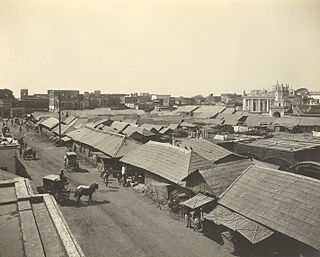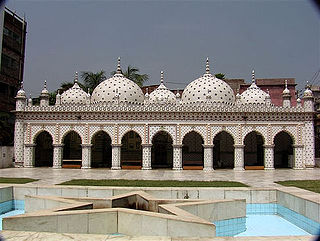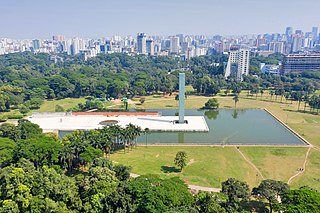 W
WAhsan Manzil used to be the official residential palace and seat of the Nawab of Dhaka. The building is situated at Kumartoli along the banks of the Buriganga River in Dhaka, Bangladesh. Construction was started in 1859 and was completed in 1872. It was constructed in the Indo-Saracenic Revival architecture. It has been designated as a national museum.
 W
WThe architecture of Dhaka is a confluence of many architectural styles. From the Sena temples built by Ballal Sen, to the Mughal architecture of the Mughals, to the Indo-Saracenic style of the colonial era, to 20th century steel and chrome of skyscrapers. Dhaka has a colonial core in the river port area, surrounded by progressively newer areas as one travels away from the Buriganga, punctuated with old temples, churches and mosques.
 W
WBangabandhu Sheikh Mujibur Rahman Novo Theatre is a planetarium on Bijoy Sharani Avenue of Tejgaon area in Dhaka, Bangladesh.
 W
WBangladesh National Zoo, is a zoo located in the Mirpur section of Dhaka, the capital city of Bangladesh. The zoo contains many native and non-native animals and wild life, and hosts about three million visitors each year. The name of zoo has been changed from 5 February 2015 from Dhaka Zoo to Bangladesh National Zoo.
 W
WBara Katra, a historical and architectural monument, is one of the oldest buildings in Dhaka. The word Katra may have originated from Arabic word Katara which means colonnaded building. 'Katra/ katara' in Arabic and Persian means 'Caravan (Karwan) Sarai' or simply a 'Sarai'. It is a palatial building dating to the reign of the Mughal dynasty in the Bengal region. It is situated to the south of Chowk Bazaar close to the north bank of the river Buriganga.
 W
WChhota Katra is one of the two Katras built during Mughal's regime in Dhaka, Bangladesh. It was constructed in 1663 by Subahdar Shaista Khan. It is on Hakim Habibur Rahman lane on the bank of the Buriganga River. Basically it was built to accommodate some officials and Shaista Khan's expanding family. Chhota Katra is slightly smaller than Bara Katra, but similar in plan and it is about 185 metres east to it.
 W
WChawk Bazaar is a well known bazaar in Chowkbazar Thana, Old Dhaka, Bangladesh. It dates back to the Mughal period.
 W
WThe Curzon Hall is a British Raj-era building and home of the Faculty of Sciences at the University of Dhaka.
 W
WDhakeshwari National Temple is a Hindu temple in Dhaka, Bangladesh. It is state-owned, giving it the distinction of being Bangladesh's 'National Temple'. The name "Dhakeshwari" means "Goddess of Dhaka". Since the destruction of Ramna Kali Mandir in 1971 by the Pakistan Army during the Bangladesh Liberation War, the Dhakeshwari Temple has assumed status as the most important Hindu place of worship in Bangladesh. It is also the largest Hindu temple in Bangladesh. This temple is part of the famous Shakti Peethas in Indian Subcontinent. Here the gem of sati's crown had fallen.
 W
WDhanmondi Lake is a lake located in the Dhanmondi residential area in Dhaka, Bangladesh. The lake was originally a dead channel of the Karwan Bazar River, and was connected to the Turag River. The lake is partially connected with the Begunbari Canal. In 1956, Dhanmondi was developed as a residential area. In the development plan, about 16% of the total area of Dhanmondi was designated for the lake.
 W
WDoel Square is one of the popular areas of the University of Dhaka campus located in Shahbag, Dhaka. There is sculpture of Oriental magpie-robin in the middle of the Doel Square. The oriental magpie-robin is the national bird of Bangladesh and locally known as the doyel or doel. The sculpture's architect is Azizul Jalil Pasha. Doel Square is a bearer and carrier of the national culture of Bangladesh.
 W
WDrik Picture Library is a picture library based in Dhaka, Bangladesh.
 W
WThe Hussaini Dalan is an Imambara that was originally built during the later half of the Mughal rule in the 17th century in Dhaka. It was built as the Imambara of the Shia Muslim community. Hussaini Dalan serves as the main Hussainiya of Dhaka, or venue for majlis or gatherings held during the month of Muharram, the tenth day religious gathering commemorates the martyrdom of Hussain, the grandson of the Islamic prophet Muhammad.
 W
WJatiya Sangsad Bhaban or National Parliament House, is the house of the Parliament of Bangladesh, located at Sher-e-Bangla Nagar in the Bangladeshi capital of Dhaka. Designed while the country was still part of Pakistan by architect Louis Kahn, the complex is one of the largest legislative complexes in the world, comprising 200 acres (810,000 m2).
 W
WLalbagh Fort is an incomplete 17th-century Mughal fort complex that stands before the Buriganga River in the southwestern part of Dhaka, Bangladesh. The construction was started in 1678 AD by Mughal Subahdar Muhammad Azam Shah, who was a son of Emperor Aurangzeb and later emperor himself. His successor, Shaista Khan, did not continue the work, though he stayed in Dhaka up to 1688.
 W
WModer Gorob or Our Pride is a sculpture situated in front of Bangla Academy building in Dhaka, Bangladesh. It was dedicated to the memory of those killed during the Bengali Language Movement demonstrations of 1952, when protesters demanding Bengali as a state language of former Dominion of Pakistan were massacred by Pakistan Police.
 W
WMoinot Ghat is a tourist attraction in Dohar Upazila of Dhaka.
 W
WThe Museum of Independence in Dhaka, Bangladesh depicts the struggle for independence of Bangladesh. It shows the history of the nation since Mughal tenure to independence in 1971. It is the first and only underground museum in the country. The museum is part of a 67-acre complex at Suhrawardy Udyan, the site from where Sheikh Mujibur Rahman gave his historic speech declaring the struggle for independence, and where the Pakistani forces surrendered after the War of Liberation. The museum was opened to public on March 25, 2015, the 45th Independence Day of Bangladesh.
 W
WNew Market is a commercial shopping market in north of Azimpur, Dhaka.
 W
WShapla Square is a huge sculpture at the heart of Motijheel near the center of Dhaka, the capital of Bangladesh. It depicts a Shapla, the national flower of Bangladesh. The sculpture is surrounded by a fountain.
 W
WStar Mosque, is a mosque located in Armanitola area, Dhaka, Bangladesh. The mosque has ornate designs and is decorated with motifs of blue stars. It was built in the first half of the 19th century by Mirza Golam Pir.
 W
WSwadhinata Stambha or Independence Monument is a national monument in Bangladesh to commemorate the historical events that took place in the Suhrawardy Udyan, previously known as Ramna Race Course ground regarding the Liberation War of Bangladesh.
 W
WTaj Mahal Bangladesh is a full-scale copy of the original Taj Mahal located 16 kilometres (10 mi) east of the Bangladeshi capital, Dhaka in Sonargaon. Unlike the original, work on the building took only five years. Ahsan Ullah Moni, a wealthy Bangladeshi film-maker, announced his 'Copycat version of Taj Mahal' project in December 2008. The project cost about US$56 Million, and was built 32 kilometres (20 mi) northeast of Dhaka. Moni has explained that he built a replica of the Taj Mahal so that the poor of his nation can realise their dream of seeing neighbouring India's famed monument. This caused complaints from Indian officials, "You can't just go and copy historical monuments" an official of Indian High Commission in Dhaka told press.